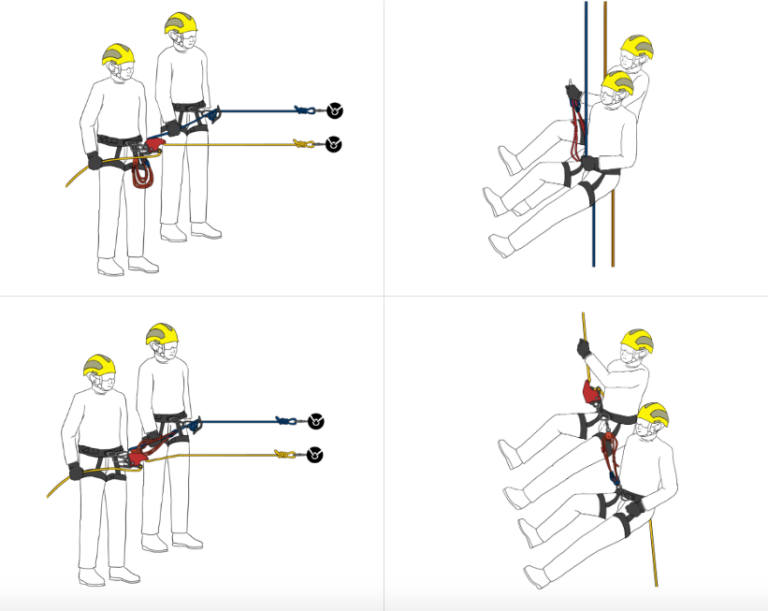Using the Harken CMC Clutch and AZTEK for a Rescue Pickoff
In the following illustrated examples, we are using the Harken CMC Clutch and AZTEK Mechanical Advantage (“set of fours”) system to conduct a safe and effective rescue pickoff.
Independent Belay: Safety First
Since a rappel pickoff is a rescue operation, an independent belay line should always be used. For clarity, the belay line has been left out of these illustrations.
- If a team has a second rope or can double a single rope but lacks an available belayer, a backup device or prusik hitch can serve as the belay.
- The backup system must be securely attached to the rappel line, ensuring two independent systems are in place.
Important: Even with a backup system, having a qualified belayer provides an added layer of safety.
Performing a Rappel Pickoff with the CMC Clutch
The CMC Clutch is rated for loads up to 600 lbs (272 kg), making it suitable for many rescue scenarios but not for heavier weights or rapid descents. Descent rates must remain slow and controlled (≤ 1 foot per second).
Steps to Begin the Rescue:
- Anchor and Gear Setup
- Attach the descender (CMC Clutch) to a stable anchor point.
- Ensure the load tender and AZTEK system are properly attached and ready.
- Descent and Patient Access
- Begin the descent while monitoring the patient’s weight and position.
- Upon reaching the patient, attach the AZTEK system securely to their harness.
- Confirm that the AZTEK supports the patient’s weight, not just the descender.
- Lowering the Patient
- Slowly lower the patient to safety using the AZTEK and CMC Clutch.
- Once the ground is reached, detach all equipment and secure it for future use.
Related Reading: Rescue Rope Frequently Asked Questions
Setting Up Systems for Pickoffs
Depending on the scenario, rescuers may require a vertical or free-hanging rope system:
- For vertical systems, attach components directly to the descender.
- For free-hanging systems, connect one end of the AZTEK to the descender and the other to a carabiner, providing greater flexibility to establish an optimal pickoff point.
Ensure all components are secure and rigged properly before initiating the rescue.
Using the AZTEK System for Pickoffs
The AZTEK system is a multi-purpose mechanical advantage system that excels in vertical or free-hanging rescues:
- Ideal for tower rescues and environments requiring the subject to be lifted away from fall arrest lanyards or other suspended systems.
- During a rappel pickoff:
- If the subject is suspended (e.g., fall arrest lanyard), the AZTEK allows the rescuer to lift the subject just high enough to disconnect them.
- This makes it safe and efficient to transition the subject to the AZTEK for descent.
Learn More: Rescue Rope Construction
Key Steps: Descent and Connection
- Stopping and Tying Off
- After reaching the subject, stop and tie off the descender to stabilize the system.
- Position yourself just above the subject for better access to connect the load tender.
- Rescuer Foot Placement
- Ensure your feet are level with the subject’s hips to maintain control over their body position.
- On stable, wide ledges, ensure enough space for secure footing.
- If fitting a harness, position yourself slightly lower for proper access and control.
- Controlled Lowering
- Once the subject is connected to the AZTEK:
- Unlock the descender carefully.
- Lower both the subject and yourself smoothly and steadily to avoid shock loading.
- Once the subject is connected to the AZTEK:
Why Precision Matters
Maintaining a slow, controlled descent is critical. Sudden shock loads can cause injury to the subject or compromise system integrity. Focus on:
- Maintaining a smooth and steady lowering process.
- Checking the AZTEK system connections and load-bearing components.
Explore More: A Rescue Rope and Cord Overview
Final Considerations for a Rappel Pickoff
- Always ensure two independent systems (rappel and belay).
- Positioning your feet level with the subject’s hips improves control.
- The AZTEK system provides flexibility for lifting subjects in both tower rescues and fall arrest scenarios.
- Review and practice rope rescue techniques regularly to ensure proficiency.
Proper planning, smooth execution, and rigorous safety checks will ensure the success of any rappel pickoff rescue.
Peace on Your Days
Lance









